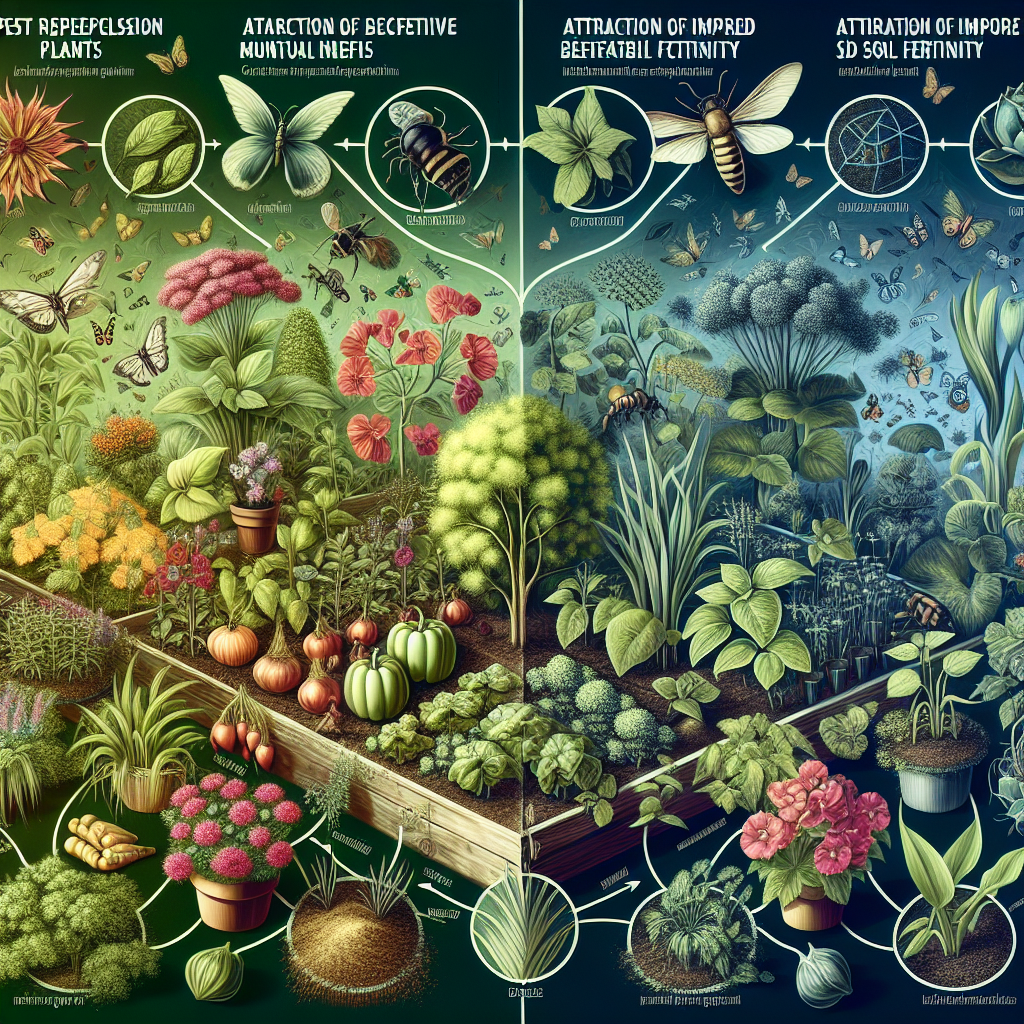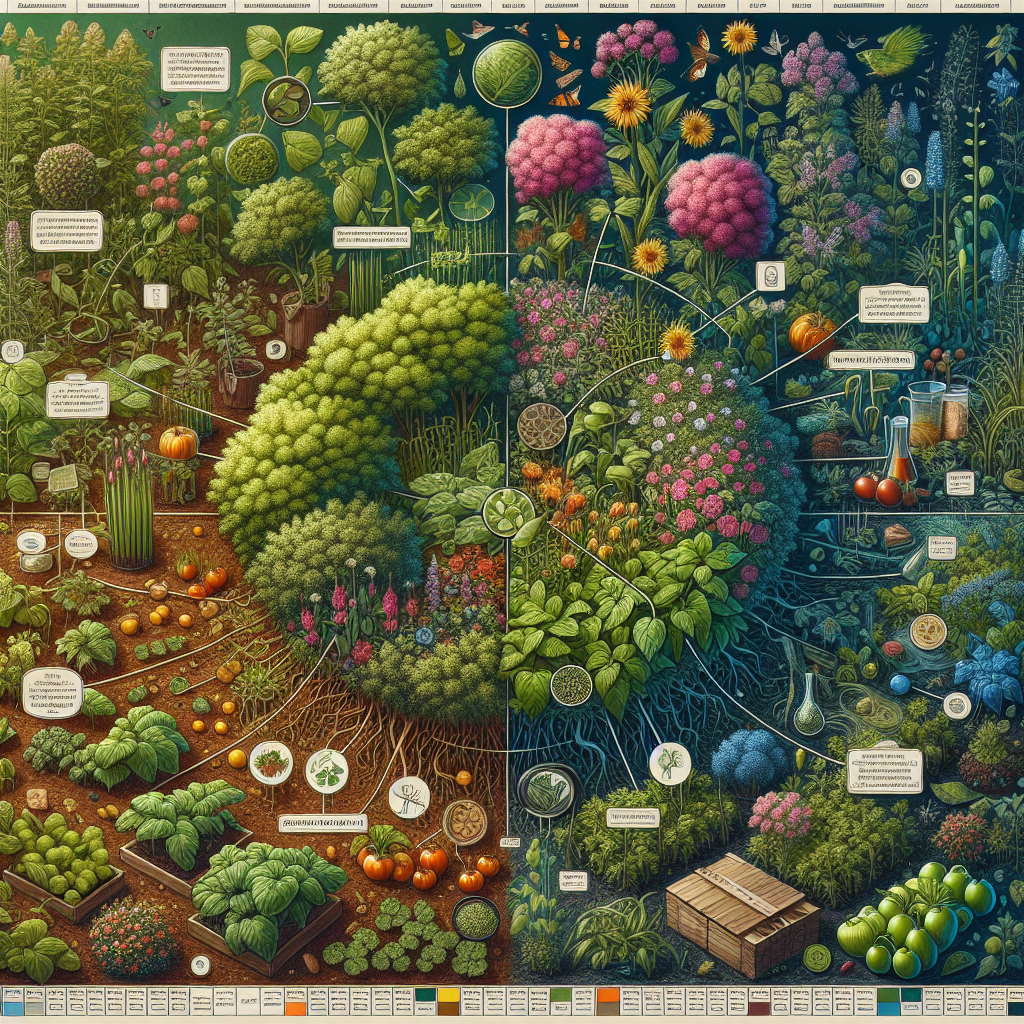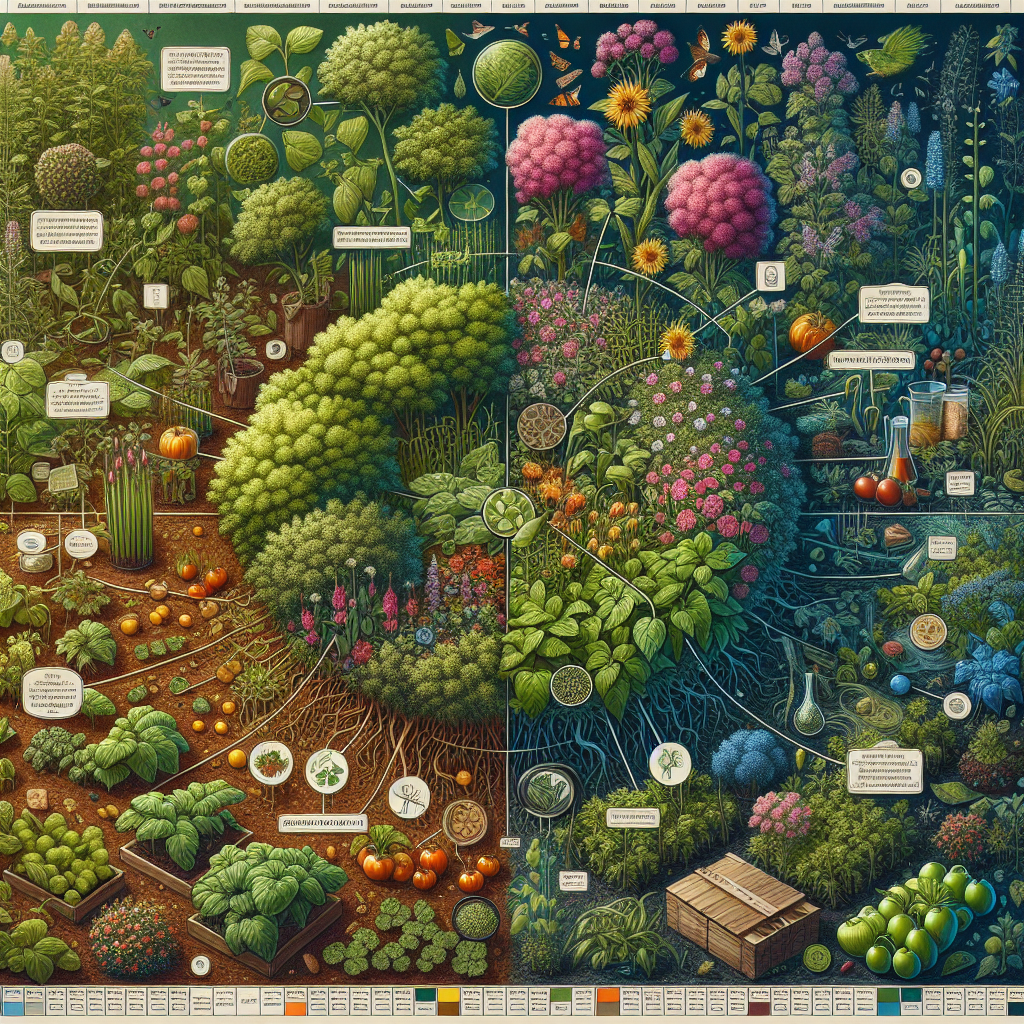If you want to create a healthier and more productive garden, then it’s time to consider the benefits of companion planting. By strategically selecting plants that complement each other and provide natural pest control and nutrient enrichment, you can cultivate a harmonious garden ecosystem that thrives with little intervention. In this article, we will explore various companion planting strategies that will not only enhance the beauty of your garden but also promote its overall health and well-being. So grab your gardening gloves and get ready to discover the secrets to a flourishing garden!

What is companion planting?
Definition and concept
Companion planting refers to the practice of planting different species of plants together to benefit each other in various ways. The concept is based on the belief that certain plants have natural affinities for each other and can promote growth, health, and productivity when planted in close proximity.
Historical background
Companion planting has a rich history that dates back centuries. Ancient cultures like the Native Americans and the Chinese practiced this gardening technique, incorporating plant combinations for mutual benefit. For example, the Native Americans planted corn, beans, and squash together, a combination known as the “Three Sisters,” where each plant supported and enhanced the growth of the others.
Principles of companion planting
There are several principles that guide the practice of companion planting. The primary principle is selecting plants that have a mutually beneficial relationship. This can involve plants that enrich the soil, repel pests, or attract beneficial insects. Other principles include considering plant compatibility, growth patterns, and succession planting.
Benefits of companion planting
Natural pest control
One of the significant benefits of companion planting is natural pest control. Certain plant combinations can effectively repel pests and deter them from infesting your garden. For example, planting marigolds alongside tomatoes can help keep aphids and nematodes at bay, protecting the health of your tomato plants.
Enhanced pollination
Companion planting can also enhance pollination, resulting in better fruit set and increased yields. By planting flowers that attract pollinators near your vegetable plants, you can ensure that bees and other beneficial insects visit your garden, pollinating your crops and boosting productivity.
Increased crop yield
Companion planting has been shown to increase crop yield. When you strategically pair plants that complement each other, they can work synergistically to enhance growth and productivity. For instance, planting basil alongside tomatoes can improve the flavor and overall health of the tomatoes, resulting in a more abundant harvest.
Diversified garden ecosystem
Companion planting contributes to a diversified garden ecosystem. By combining different species of plants, you create a habitat that attracts a variety of organisms. This diversity promotes a balance in the ecosystem, reducing the risk of pest outbreaks and improving overall garden health.
Weed suppression
Companion planting can help suppress weeds, reducing the need for excessive manual weeding or chemical herbicides. Some plants, like certain groundcovers or densely growing vegetables, can act as natural weed suppressants, choking out unwanted plant growth and minimizing competition for resources.
Improved soil health
Many companion plants aid in improving soil health. Some plants, known as nitrogen-fixing plants, have the ability to convert atmospheric nitrogen into a usable form for other plants. By interplanting nitrogen-fixing plants like legumes with other crops, you can effectively enrich the soil with nitrogen, an essential nutrient for plant growth. Additionally, certain plants can act as dynamic accumulators, drawing up nutrients from deep within the soil and making them available to neighboring plants.
Choosing the right companion plants
Plant compatibility
When selecting companion plants, it is crucial to consider their compatibility. Some plants thrive when planted together, while others may compete for resources or inhibit each other’s growth. By researching and understanding the preferences and needs of different plant species, you can make informed choices about suitable companions.
Complementary growth patterns
Choosing companion plants with complementary growth patterns can be beneficial for maximizing space and resources. Tall plants, for example, can provide shade or support for shorter plants. Plants with shallow root systems can coexist with those that have deeper roots, minimizing competition for nutrients and water.
Succession planting considerations
Succession planting involves sowing and harvesting crops in staggered intervals throughout the growing season. When selecting companion plants, it is essential to consider their growth rates and harvest times. This way, you can ensure a continuous supply of fresh produce and efficient use of garden space.
Identifying beneficial plant interactions
Certain plants have known beneficial interactions with others. For example, planting chives near roses can help deter aphids, while interplanting carrots and onions can repel carrot flies. By identifying and utilizing these beneficial plant interactions, you can create a harmonious garden environment that encourages healthy growth and minimizes pest issues.
Avoiding incompatible companion plants
Plants with incompatible root systems
Incompatible companion plants are those with conflicting root systems. For instance, plants with aggressive, spreading roots can stunt the growth of their neighboring plants by competing for space and nutrients. It is crucial to research the root characteristics of different plant species to avoid such incompatibilities.
Plants with conflicting nutrient needs
Certain plants have specific nutrient requirements that may conflict with those of other plants. For example, planting brassicas, which are heavy feeders, alongside legumes, which fix nitrogen, can lead to imbalanced nutrient levels in the soil. Understanding the nutrient needs of different plants and ensuring compatibility is important for maintaining optimal garden health.
Plants with allelopathic effects
Some plants release chemical compounds that can inhibit the growth of neighboring plants. Known as allelopathy, this phenomenon can negatively impact crop yield and overall garden health. Examples include black walnut trees, which produce a natural herbicide that can be detrimental to certain plant species. Researching and avoiding plants with allelopathic effects is necessary to prevent such issues.
Chemical sensitivities
Some plants are sensitive to certain chemicals, such as herbicides or pesticides, used on neighboring plants. It is crucial to avoid planting sensitive species near plants that require chemical treatments, as it can lead to unintended damage or death of the sensitive plants. Researching the chemical sensitivities of different plants is essential for maintaining a healthy garden.

Attracting beneficial insects
Understanding beneficial insects
Beneficial insects play a vital role in pest control and pollination. Ladybugs, lacewings, and hoverflies, for example, feed on garden pests like aphids and caterpillars. By attracting and encouraging the presence of these beneficial insects in your garden, you can effectively reduce pest populations without relying on chemical pesticides.
Flowering plants for insect attraction
To attract beneficial insects, it is important to incorporate flowering plants into your garden design. Flowers with composite blossoms, such as asters and sunflowers, are particularly attractive to beneficial insects. Herbs like dill, cilantro, and fennel also produce tiny flowers that provide nectar and pollen for beneficial insects.
Using decoy plants to lure pests away
Certain plants can act as decoys, luring pests away from your valuable crops. For example, planting nasturtiums near brassicas can attract aphids, diverting them from your cabbage or broccoli. By sacrificing a few leaves or flowers to pests, you can protect your main crops and maintain a healthy garden.
Creating insect habitats
Providing shelter and habitats for beneficial insects is crucial in attracting and retaining them in your garden. This can be achieved by incorporating features like insect hotels, which provide crevices and nesting sites for beneficial insects. Additionally, leaving some areas of your garden wild or adding flowering shrubs can create diverse habitats that support a wide range of beneficial insects.
Repelling pests naturally
Natural pest deterrent plants
Certain plants have natural pest-repellent properties and can be effective in deterring pests from your garden. For example, planting garlic or onions near susceptible crops can repel pests like aphids, carrot flies, and cabbage worms. Other pest-repellent plants include marigolds, nasturtiums, and catnip. Utilizing these plants strategically can help reduce pest damage without resorting to chemical pesticides.
Companion plant combinations for pest control
Companion planting can also involve selecting specific plant combinations that work together to control pests. For instance, planting radishes near cucumbers can repel cucumber beetles, while also benefiting from the cucumbers’ shade. Researching and implementing these combinations can minimize pest issues and promote a healthier garden ecosystem.
Repellent qualities of certain scents
Certain scents can repel pests by masking the attractive odors emitted by vulnerable crops. For example, planting aromatic herbs like mint, rosemary, and thyme near susceptible plants can confuse and deter pests like aphids and cabbage moths. The strong scents of these herbs can serve as a natural pest barrier, reducing the need for chemical interventions.
Improving soil fertility
Nitrogen-fixing plants
Nitrogen is an essential nutrient for plant growth, and nitrogen-fixing plants play a crucial role in improving soil fertility. Legumes, such as peas and beans, have the ability to convert atmospheric nitrogen into a form that other plants can utilize. By incorporating nitrogen-fixing plants into your garden, you can naturally enrich the soil without relying on synthetic fertilizers.
Dynamic accumulators
Dynamic accumulators are plants that have deep root systems and can mine nutrients from deeper soil layers. These plants accumulate nutrients in their leaves or stems, which can be returned to the soil when they are pruned or mulched. Examples of dynamic accumulators include comfrey and borage, which bring up nutrients like potassium, calcium, and trace minerals from the subsoil.
Cover crops for soil improvement
Cover crops are an effective way to improve soil health. They are typically planted during off-seasons or as part of crop rotation cycles to protect and enrich the soil. Cover crops like clover, rye, and buckwheat offer numerous benefits, including preventing erosion, suppressing weeds, and adding organic matter to the soil as they decompose.
Compost and mulching
Composting and mulching are essential practices for improving soil fertility. Compost provides a rich source of organic matter and nutrients, aiding in soil structure and nutrient availability. Mulching helps retain moisture, suppress weeds, and gradually enrich the soil as the organic matter breaks down. Both practices contribute to overall soil health and fertility.
Companion planting for disease prevention
Companion plants with disease resistance
Some plants have natural resistance or tolerance to certain diseases or pests. By strategically planting these disease-resistant companions, you can help prevent the spread and severity of diseases in your garden. For example, planting French marigolds alongside tomatoes can help deter nematodes, a common pest that damages tomato roots.
Crop rotation and disease prevention
Proper crop rotation is an essential disease prevention strategy in companion planting. Rotating crops and avoiding planting the same species or family in the same location year after year helps break the lifecycle of pests and pathogens. By following a crop rotation plan, you can reduce the risk of disease buildup in the soil and maintain the health of your garden.
Suppressing soil-borne diseases
Certain companion plants have the ability to suppress soil-borne diseases through their root exudates or allelopathic effects. For example, planting brassicas like broccoli or cabbage with alliums like onions or garlic can help reduce the incidence of diseases like clubroot. These antagonistic relationships between plants can contribute to disease prevention and healthier garden conditions.
Companion planting in container gardens
Container size and plant compatibility
When practicing companion planting in container gardens, it is essential to consider the size of the container and the compatibility of the plants. Selecting plants with similar water and light requirements, as well as appropriate container sizes, will ensure that they can coexist harmoniously without competing for resources or overcrowding each other.
Vertical gardening and space optimization
Vertical gardening is an excellent technique for maximizing space in container gardens. By incorporating climbing plants like peas, cucumbers, or beans alongside taller plants, you can efficiently utilize vertical space. This not only reduces the footprint of your garden but also allows for more diverse companion plant combinations.
Companion planting tips for potted plants
When companion planting in pots, choose plants that have similar growth rates, root systems, and nutrient requirements. Avoid combining plants with invasive or aggressive root systems, as they can quickly outcompete or overtake other plants in the limited space of a container. Regular monitoring and maintenance, such as pruning and repotting as needed, are also essential for the health and longevity of your potted companion plants.
Incorporating companion planting strategies into your garden can have numerous benefits, ranging from natural pest control to improved soil fertility and disease prevention. By carefully selecting the right companion plants, avoiding incompatible combinations, and creating a diverse ecosystem, you can create a vibrant and healthy garden that thrives without excessive reliance on chemical interventions. So, experiment with different companion plant combinations, observe and learn from your garden, and enjoy the bountiful rewards of a well-planned companion planting strategy.

